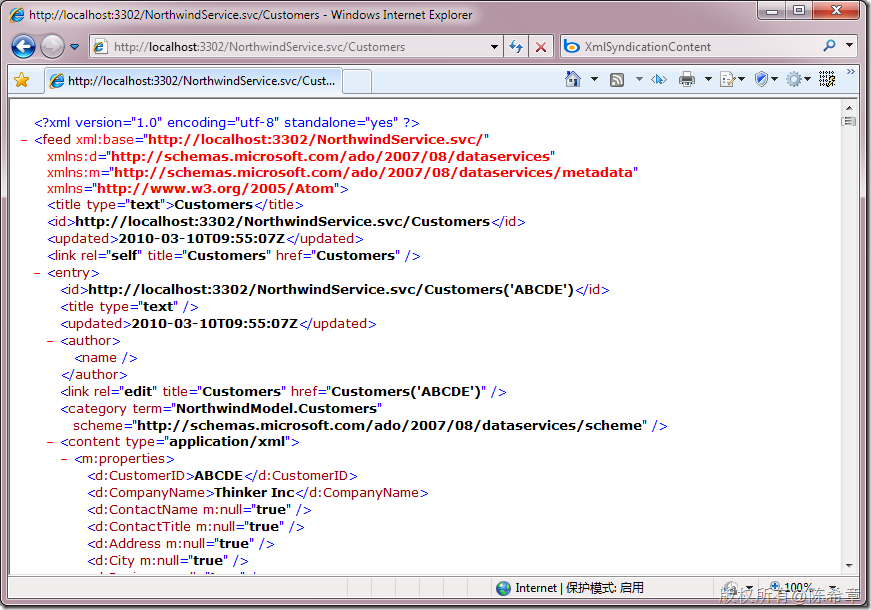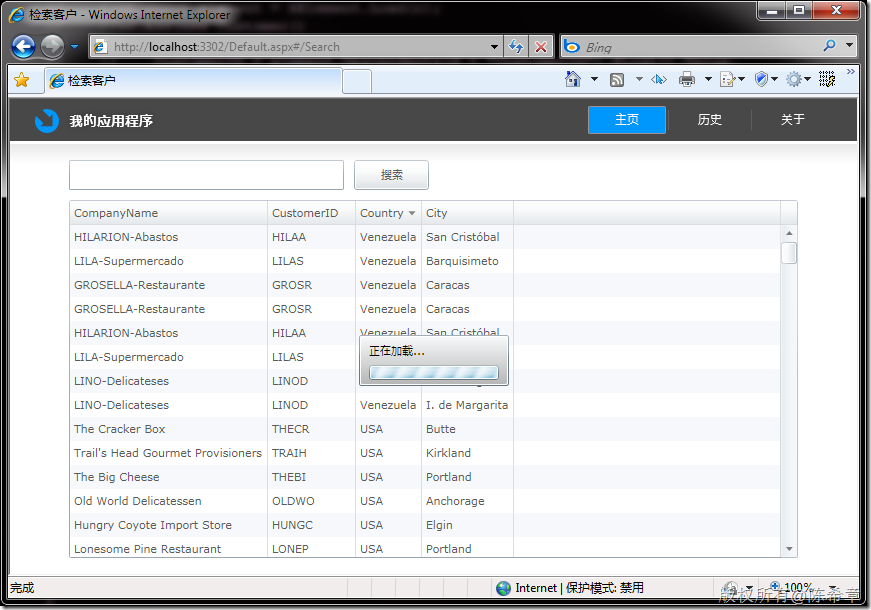1。 数据服务的返回数据格式
注意,没有办法通过添加引用的方式调用该服务,估计有安全方面的一些考虑吧
2。因为ADO.NET数据服务是可以直接通过http请求实现,所以下面两个代码都可以完成工作
首先准备地址和查询,并且直接通过webclient来发起请求即可
Uri svc = new Uri(Application.Current.Host.Source, "../NorthwindService.svc/Customers()?$orderby=CustomerID desc");
WebClient proxy = new WebClient();
proxy.OpenReadCompleted += new OpenReadCompletedEventHandler(proxy_OpenReadCompleted);
proxy.OpenReadAsync(svc);然后在proxy_OpenReadCompleted方法中编写如下代码即可 XNamespace d = "http://schemas.microsoft.com/ado/2007/08/dataservices";
XNamespace xmlns = "http://www.w3.org/2005/Atom";
XDocument doc = XDocument.Load(e.Result);
var query = from entry in doc.Root.Elements(xmlns + "entry")
select new Customer()
{
CustomerID = entry.Descendants(d + "CustomerID").First().Value,
CompanyName = entry.Descendants(d + "CompanyName").First().Value,
Country = entry.Descendants(d + "Country").First().Value,
City = entry.Descendants(d + "City").First().Value
};
foreach (var item in query)
{
oc.Add(item);
}
另外,因为数据服务返回的数据其实是基于ATOM格式的,所以还可以通过下面的方式解析
XNamespace d = "http://schemas.microsoft.com/ado/2007/08/dataservices";
XNamespace xmlns = "http://www.w3.org/2005/Atom";
#region //读取到数据进行解析
XmlReader reader = XmlReader.Create(e.Result);
SyndicationFeed feed = SyndicationFeed.Load(reader);
foreach (var item in feed.Items)
{
XmlSyndicationContent c = (XmlSyndicationContent)item.Content;
XmlDictionaryReader r = c.GetReaderAtContent();
XElement element = XElement.Load(r);
oc.Add(new Customer()
{
CustomerID = element.Descendants(d + "CustomerID").First().Value,
CompanyName = element.Descendants(d + "CompanyName").First().Value,
Country = element.Descendants(d + "Country").First().Value,
City = element.Descendants(d + "City").First().Value
});
r.Close();
oc.Add(LoadXml
(r));
}
reader.Close();
大家可以看出两个方法其实有相似之处,因为都涉及到了XML的解析。但他们也有类似的一个问题,就是如果我们的类型属性很多,那么那些代码很繁琐。不是吗?其实是有规律可循的。我一般会用下面的方法来解决问题
///
/// 这是一个静态方法,可以将一段XML转换为一个对象
///
///
///
///
public static T LoadXml
(XmlReader reader)
where T:
new()
{
XNamespace d =
"http://schemas.microsoft.com/ado/2007/08/dataservices";
XElement element = XElement.Load(reader);
T result =
new T();
foreach (var p
in
typeof(T).GetProperties())
{
Type pType = p.PropertyType;
string pName = p.Name;
string pValue = element.Descendants(d + pName).First().Value;
p.SetValue(result, Convert.ChangeType(pValue, pType,
null),
null);
}
reader.Close();
return result;
}
///
/// 这是一个静态方法,可以将一段XML转换为一个对象
///
///
///
///
public
static T LoadXml
(XElement element)
where T :
new()
{
XNamespace d =
"http://schemas.microsoft.com/ado/2007/08/dataservices";
T result =
new T();
foreach (var p
in
typeof(T).GetProperties())
{
Type pType = p.PropertyType;
string pName = p.Name;
string pValue = element.Descendants(d + pName).First().Value;
p.SetValue(result, Convert.ChangeType(pValue, pType,
null),
null);
}
return result;
}
这样一来,我们的代码就可以简化成下面这样,看起来不错对吧
var query = from entry in doc.Root.Elements(xmlns + "entry")
select LoadXml
(entry);








 本文介绍如何使用ADO.NET数据服务获取并解析数据。通过HTTP请求获取数据后,利用XDocument和XmlReader两种方式进行数据解析,并提供了简化代码的方法。
本文介绍如何使用ADO.NET数据服务获取并解析数据。通过HTTP请求获取数据后,利用XDocument和XmlReader两种方式进行数据解析,并提供了简化代码的方法。


















 12
12

 被折叠的 条评论
为什么被折叠?
被折叠的 条评论
为什么被折叠?








